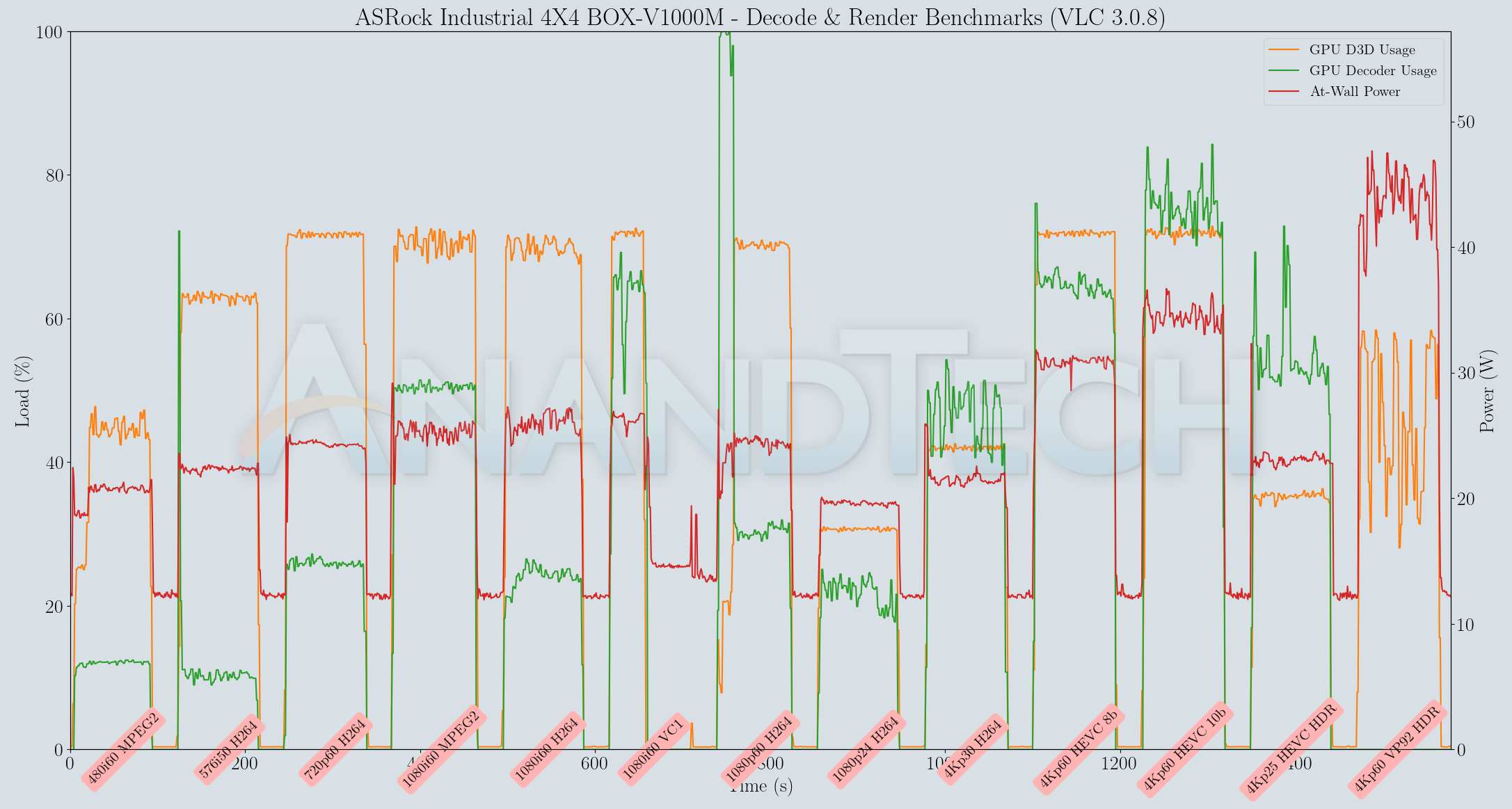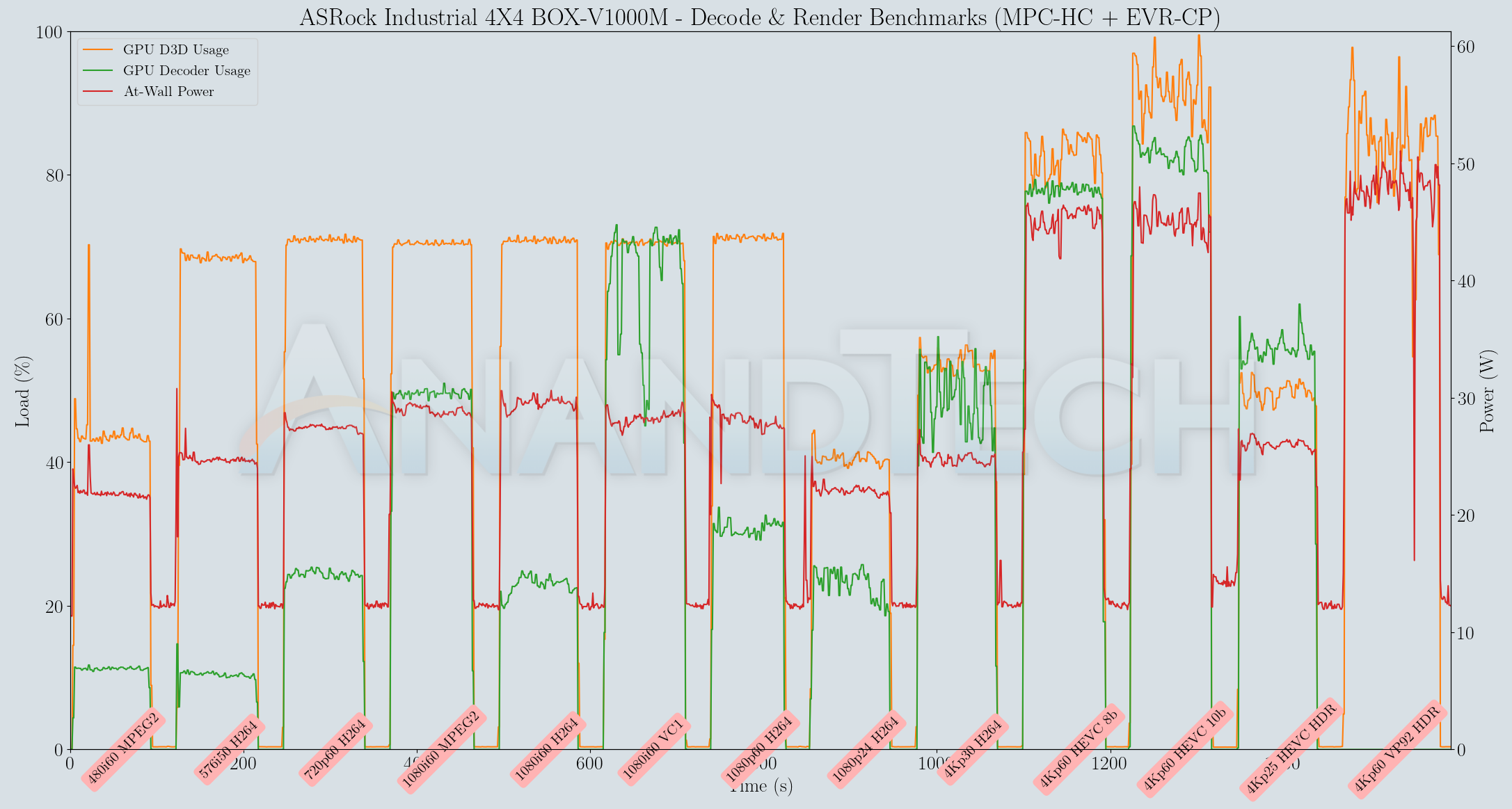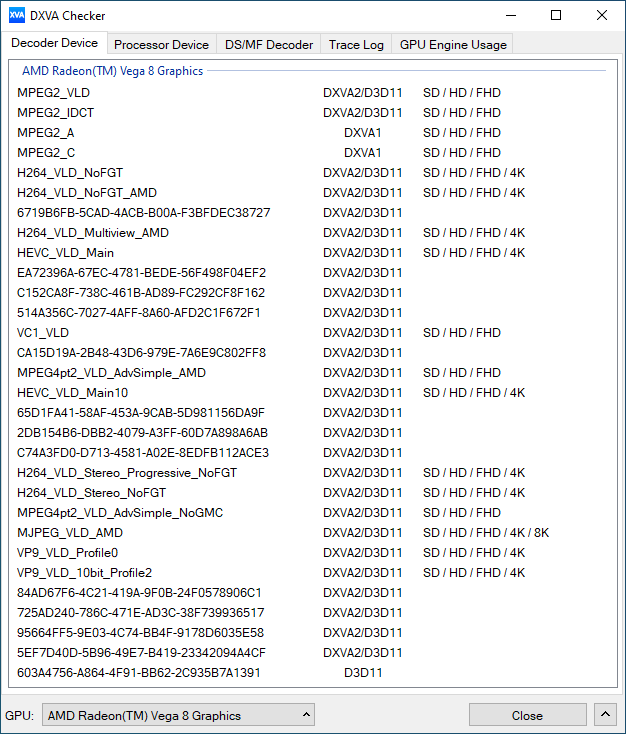ASRock Industrial 4X4 BOX-V1000M Ryzen Mini-PC Review: Finding Zen In The Small Things
by Ganesh T S on September 28, 2020 8:00 AM EST- Posted in
- Systems
- AMD
- NUC
- UCFF
- Ryzen
- Ryzen Embedded
- ASRock Industrial
HTPC Credentials - Local Media Playback and Video Processing
Evaluation of local media playback and video processing is done by playing back files encompassing a range of relevant codecs, containers, resolutions, and frame rates. A note of the efficiency is also made by tracking GPU usage and power consumption of the system at the wall. Users have their own preference for the playback software / decoder / renderer, and our aim is to have numbers representative of commonly encountered scenarios. Towards this, we played back the test streams using the following combinations:
- MPC-HC x64 1.8.5 + LAV Video Decoder (DXVA2 Native) + Enhanced Video Renderer - Custom Presenter (EVR-CP)
- MPC-HC x64 1.8.5 + LAV Video Decoder (D3D11) + madVR 0.92.17 (DXVA-Focused)
- MPC-HC x64 1.8.5 + LAV Video Decoder (D3D11) + madVR 0.92.17 (Lanczos-Focused)
- VLC 3.0.8
- Kodi 18.6
The thirteen test streams (each of 90s duration) were played back from the local disk with an interval of 30 seconds in-between. Various metrics including GPU usage and at-wall power consumption were recorded during the course of this playback. Prior to looking at the metrics, a quick summary of the decoding capabilities of the Vega 8 integrated GPU is useful to have for context.
Accelerated decoding support up to 4K resolution is available for AVC, HEVC (8b and 10b), MPEG-4, and VP9 (8b and 10b). MJPEG decoding support exists for up to 8K resolution and VC1 for up to 1080p.
All our playback tests were done with the desktop HDR setting turned on. It is possible for certain system configurations to have madVR automatically turn on/off the HDR capabilities prior to the playback of a HDR video, but, we didn't take advantage of that in our testing.
VLC and Kodi
VLC is the playback software of choice for the average PC user who doesn't need a ten-foot UI. Its install-and-play simplicity has made it extremely popular. Over the years, the software has gained the ability to take advantage of various hardware acceleration options. Kodi, on the other hand, has a ten-foot UI making it the perfect open-source software for dedicated HTPCs. Support for add-ons make it very extensible and capable of customization. We played back our test files using the default VLC and Kodi configurations, and recorded the following metrics.
| Video Playback Efficiency - VLC and Kodi | |||

The graphs above indicate that the decoding of the interlaced VC-1 stream is finicky with both VLC and Kodi. Another interesting aspect is that VLC doesn't use accelerated decoding for the VP9 Profile 2 stream, while Kodi does. Other than VC-1 playback (which was fine with the official Video player app in Windows), the decoder testing process was smooth. At-Wall power consumption for the system ranged from 20W-45W depending on the stream and the player.
MPC-HC
MPC-HC offers an easy way to test out different combinations of decoders and renderers. The first configuration we evaluated is the default post-install scenario, with only the in-built LAV Video Decoder forced to DXVA2 Native mode. Two additional passes were done with different madVR configurations. In the first one (DXVA-focused), we configured madVR to make use of the DXVA-accelerated video processing capabilities as much as possible. In the second (Lanczos-focused), the image scaling algorithms were set to 'Lanczos 3-tap, with anti-ringing checked'. Chroma upscaling was configured to be 'BiCubic 75 with anti-ringing checked' in both cases. The metrics collected during the playback of the test files using the above three configurations are presented below.
| Video Playback Efficiency - MPC-HC with EVR-CP and madVR | |||

The 4Kp60 streams were a hit or a miss with the different combinations tested above. VC-1 playback was sensitive to madVR settings (working well with DXVA scaling, but failing with the custom configuration). Other 1080p and lower resolution streams had no trouble in playback even with the upscaling to 4K in the picture. These are to be expected, given that madVR is meant to mostly be used with discrete GPUs.











37 Comments
View All Comments
nagi603 - Monday, September 28, 2020 - link
I wish those were intel NICs instead of Realtek, but you can't win all.webdoctors - Monday, September 28, 2020 - link
Love the title, haha.I like the TDP specs of this as I built a low power home nas machine for storing surveillance videos and home automation scripts. But the pricing on this is TERRIBLE. I built a tiny SFF machine for ~$130! It was like $60 for the mobo+CPU, $50 case+PS, $20 RAM etc.
What niche is this thing trying to fulfill?
eastcoast_pete - Monday, September 28, 2020 - link
Thanks for the review, although I would have really liked to see a review of that unit with the 4800u Renoir chip. The long-term support of this unit is, of course, interesting if one deploys them in actual "industrial" settings. However, I strongly assume that most readers here would use a small format PC like this as HTPC at home, and would gladly trade the superior performance of an 8 core Renoir for the "long-term support". So, any chance of seeing that review here?GreenReaper - Monday, September 28, 2020 - link
Why doesn't it use the 10GbE provided by the CPU, even at 1Gbps? Is it a question of power usage? Cost of transceivers? Reliability?eastcoast_pete - Monday, September 28, 2020 - link
10 GbE requires additional hardware (e.g. from Aquantia, or others); the situation is similar for many Intel-based systems. A number of current CPUs are capable of supporting 10 GbE, but all need the additional hardware. In contrast, 2.5 GbE can be implemented w/o adding much to the BOM, so more systems now ship with 2.5 GbE instead of just 1 GbE.GreenReaper - Monday, September 28, 2020 - link
Also, AMD is playing silly buggers with links to its specifications; the one in the article on the model number just leads to a menu page for me. This link has a V1000-series product brief:https://www.amd.com/en/media/42701/download
nicolaim - Monday, September 28, 2020 - link
No USB-C ports on something that's supposed to last up to ten years?PyroHoltz - Monday, September 28, 2020 - link
Good point. Maybe asrock knows something that we don't and usb-c is going to be replaced in the next 5?Lord of the Bored - Wednesday, September 30, 2020 - link
I doubt the target market is going to be plugging any USB-C... whatevers. I think the only things that actually ship with a USB-C connectors are laptop "docks" and USB-grownup-connector adapters.There's literally no benefit to USB-C in this segment.
PeterEvans - Monday, September 28, 2020 - link
Well I guess this is one way to get rid of the three year old laptop parts. Just put them together into a shoebox and call it "innovative". I am surprised it doesn't come with Windows XP.